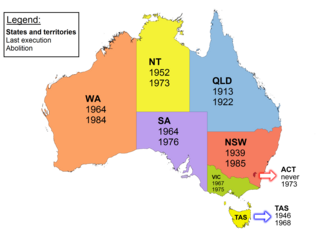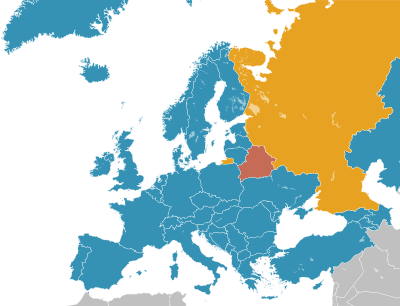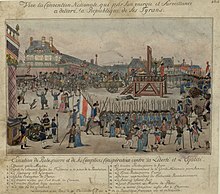Capital punishment, also known as the death penalty and formerly called judicial homicide, is the state-sanctioned practice of killing a person as a punishment for a crime, usually following an authorised, rule-governed process to conclude that the person is responsible for violating norms that warrant said punishment. The sentence ordering that an offender be punished in such a manner is known as a death sentence, and the act of carrying out the sentence is known as an execution. A prisoner who has been sentenced to death and awaits execution is condemned and is commonly referred to as being "on death row". Etymologically, the term capital refers to execution by beheading, but executions are carried out by many methods, including hanging, shooting, lethal injection, stoning, electrocution, and gassing.

A guillotine is an apparatus designed for effectively carrying out executions by beheading. The device consists of a tall, upright frame with a weighted and angled blade suspended at the top. The condemned person is secured with a pillory at the bottom of the frame, holding the position of the neck directly below the blade. The blade is then released, swiftly and forcefully decapitating the victim with a single, clean pass; the head falls into a basket or other receptacle below.

Capital punishment, also called the death penalty, is the state-sanctioned killing of a person as a punishment for a crime. It has historically been used in almost every part of the world. By the 2020s, many countries had abolished or discontinued the practice. In 2022, the 5 countries that executed the most people were, in descending order, China, Iran, Saudi Arabia, Egypt, and the United States.

Hamida Djandoubi was a Tunisian convicted murderer sentenced to death in France. He moved to Marseille in 1968, and six years later he kidnapped, tortured, and murdered 22-year-old Élisabeth Bousquet. He was sentenced to death in February 1977 and executed by guillotine in September that year. He was the last person to be executed in Western Europe, and also the last person to be lawfully executed by beheading anywhere in the Western world, although he was not the last person sentenced to death in France. Marcel Chevalier served as chief executioner.

Robert Badinter was a French lawyer, politician, and author who enacted the abolition of the death penalty in France in 1981, while serving as Minister of Justice under François Mitterrand. He also served in high-level appointed positions with national and international bodies working for justice and the rule of law.
Marcel Chevalier worked as the last chief executioner in France.
Capital punishment in Canada dates back to Canada's earliest history, including its period as a French colony and, after 1763, its time as a British colony. From 1867 to the elimination of the death penalty for murder on July 26, 1976, 1,481 people had been sentenced to death, and 710 had been executed. Of those executed, 697 were men and 13 women. The only method used in Canada for capital punishment of civilians after the end of the French regime was hanging. The last execution in Canada was the double hanging of Arthur Lucas and Ronald Turpin on December 11, 1962, at Toronto's Don Jail. The National Defence Act prescribed the death penalty for certain military offences until 1999, although no military executions had been carried out since 1946.

Capital punishment in Sweden was last used in 1910, though it remained a legal sentence for at least some crimes until 1973. It is now outlawed by the Swedish Constitution, which states that capital punishment, corporal punishment, and torture are strictly prohibited. At the time of the abolition of the death penalty in Sweden, the legal method of execution was beheading. It was one of the last states in Europe to abolish the death penalty.

Capital punishment has been completely abolished in all European countries except for Belarus and Russia, the latter of which has a moratorium and has not carried out an execution since September 1996. The complete ban on capital punishment is enshrined in both the Charter of Fundamental Rights of the European Union (EU) and two widely adopted protocols of the European Convention on Human Rights of the Council of Europe, and is thus considered a central value. Of all modern European countries, San Marino, Portugal, and the Netherlands were the first to abolish capital punishment, whereas only Belarus still practises capital punishment in some form or another. In 2012, Latvia became the last EU member state to abolish capital punishment in wartime.

Capital punishment is forbidden by the Charter of Fundamental Rights and Freedoms of the Czech Republic and is simultaneously prohibited by international legal obligations arising from the Czech Republic's membership of both the Council of Europe and the European Union.

Capital punishment in Australia was a form of punishment in Australia that has been abolished in all jurisdictions. Queensland abolished the death penalty in 1922. Tasmania did the same in 1968. The Commonwealth abolished the death penalty in 1973, with application also in the Australian Capital Territory and the Northern Territory. Victoria did so in 1975, South Australia in 1976, and Western Australia in 1984. New South Wales abolished the death penalty for murder in 1955, and for all crimes in 1985. In 2010, the Commonwealth Parliament passed legislation prohibiting the re-establishment of capital punishment by any state or territory. Australian law prohibits the extradition or deportation of a prisoner to another jurisdiction if they could be sentenced to death for any crime.

Capital punishment in Belgium was formally abolished on August 1, 1996, for all crimes, in both peacetime and wartime. The last execution for crimes committed in peacetime took place in July 1863, when in Ypres a farmer was executed for murder. The last execution for an ordinary crime took place on 26 March 1918 at Veurne Prison when Emile Ferfaille, a military officer found guilty of killing his pregnant girlfriend, was guillotined. This was the first execution to be carried out since 1863. The guillotine that was used had to be imported from France.
Capital punishment in Georgia was completely abolished on 1 May 2000 when the country signed Protocol 6 to the ECHR. Later Georgia also adopted the Second Optional Protocol to the ICCPR. Capital punishment was replaced with life imprisonment.

Capital punishment in modern Greece was carried out using the guillotine or by firing squad. It was last applied in 1972 during the military junta. The death penalty was abolished in stages between 1975 and 2005.
Capital punishment has been abolished in Mongolia since 2016, following a previous eight-year moratorium.
Capital punishment has been a legal penalty in Kenya since before its independence, and continues to be so under Kenyan law. No executions have been carried out in Kenya since 1987, when Hezekiah Ochuka and Pancras Oteyo Okumu, leaders of the 1982 coup d'état attempt, were hanged for treason.
Capital punishment has been abolished in Sierra Leone. Sierra Leone abolished capital punishment in July 2021 following a decision by the nation's Parliament.
Capital punishment is no longer a legal punishment in Rwanda. The death penalty was abolished in the country in 2007.
The Central African Republic has abolished capital punishment, after the National Assembly passed a bill abolishing it on 27 May 2022. Prior to its abolition in law, the nation was considered "Abolitionist in Practice." The country carried out its last executions, of six unnamed men, in January 1981.
Philippe Maurice was a French criminal and academic, mostly famous for being sentenced to the guillotine for murder in 1980, and subsequently pardoned by president Francois Mitterrand in 1981. His sentence of death was the last confirmed throughout the French legal system, as well as the last person to receive an executive pardon from a death sentence in France. While imprisoned Maurice became a historian, and currently specialises in Medieval history.








